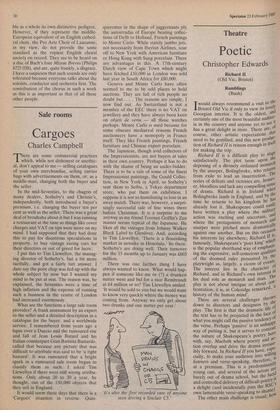Sale rooms
Cargoes
Charles Campbell
There are some commercial practices which, while not dishonest or unethic- al, don't appeal to me — selling catalogues of your own merchandise, selling carrier bags with advertisements on them, or, as a middle-man, charging both the buyer and the seller.
In the mid-Seventies, to the chagrin of many dealers, Sotheby's and Christie's, independently, both introduced a buyer's premium, i.e. charging the buyer ten per cent as well as the seller. There was a great deal of brouhaha about it but I was running a restaurant at the time so things like cover charges and VAT on tips were more on my mind. I had supposed that they had done this to pay for disastrous speculations in property, to buy vintage racing cars, for their directors or out of greed for lucre. I put this to Tim Llewellyn, the manag- ing director of Sotheby's, but a bit more tactfully, and got a fairly tart answer. I dare say the poor chap was fed-up with the whole subject by now but I wanted my mind to be put at rest. The reason was, he explained, the Seventies were a time of high inflation and the expense of running such a business in the centre of London had increased enormously. What are the functions a large sale room provides? A frank assessment by an expert to the seller and a detailed description in a catalogue for the buyer, and a worldwide service. I remembered from years ago a lapse over a Duccio and the rumoured rise and fall of Jean Louis Batard and his Italian counterpart Gian Battista Bastardo, called that because any picture that was difficult to attribute was said to be 'a right bastard'. It was rumoured that a bright spark in a rumoured sale room began to classify them as such. I asked Tim Llewellyn if there were still wrong attribu- tions. Only about 20 to 30 a year, he thought, out of the 150,000 objects that they sell in England. It would seem these days that there is a 'Cargoes' situation in reverse. Quin- queremes in the shape of juggernauts ply the autostradas of Europe bearing collec- tions of Delft to Holland, French paintings to Monte Carlo. While stately jumbo jets, not necessarily from Iberian Airlines, soar off to New York with American furniture or Hong Kong with Sung porcelain. There are advantages in this. A 17th-century Dutch view of Cape Town which might have fetched £10,000 in London was sold last year in South Africa for £80,000.
Geneva and Monte Carlo have often seemed to me to be odd places to hold auctions. They are full of rich people no doubt but. . . . The reasons are simple, I now find out. As Switzerland is not a member of the EEC there is no VAT on jewellery and they have always been keen on objets de vertu — all those watches perhaps. Monte Carlo is used because for some obscure mediaeval reasons French auctioneers have a monopoly in France itself. They like French paintings, French furniture and Chinese export porcelain.
The Japanese, though avid collectors of the Impressionists, are not buyers at sales in their own country. Perhaps it has to do with the shame of being an under-bidder. There is to be a sale of some of the finest Impressionist paintings, the Gould Collec- tion, in New York in April, so Sotheby's sent them to Seibu, a Tokyo department store, who put them on exhibition. I suppose it is not so humiliating to lose in an away match. There was, however, a surpri- singly successful sale of fine wines there before Christmas. It is a surprise to me anyway as my friend Terence Griffin's Zen master seems typical of tike Japanese. He likes all the vintages from Johnny Walker Black Label to Glenlivet. And, according to Tim Llewellyn, 'There is a flourishing market in netsuke in Honolulu.' So there. Sotheby's are doing well. Their turnover for the 15 months up to January was £603 million.
' There was one further thing I have always wanted to know. What would hap- pen if someone like me or (?) a drunken nutter went and bid for a nice Rembrandt at fit million or so? Tim Llewellyn smiled. `It would be sold to you but we would want to know very quickly where the money was coming from. Anyway we only get about two drunks and one nutter per year.'
'It's also the first recorded case of anyone seen driving a Sinclair C5.'










































 Previous page
Previous page